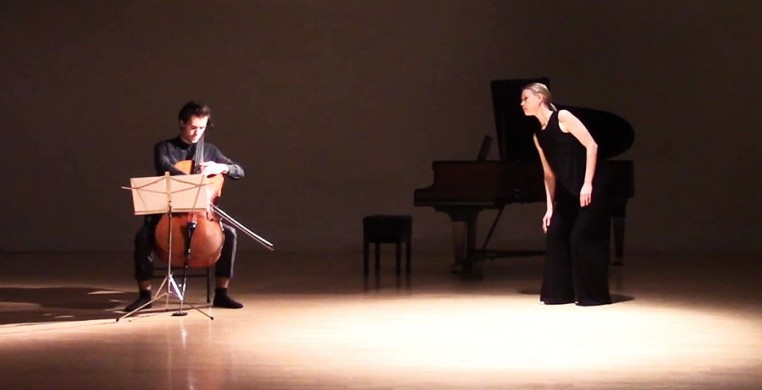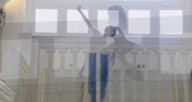Japanese native Ayako Kato has been living and working in Chicago as an independent dancer/choreographer and artistic director of Art Union Humanscape for twenty years. In that time, much of Kato’s artistic output has been committed to solo practice in collaboration with musicians, including several projects with double bassist Jason Roebke, her husband. For the past eight years, Kato has maintained a studio practice at Hamlin Park Fieldhouse, where she is an artist in residence with Chicago Moving Company. She’s developed concerts, classes, and workshops, and curated performance series including a short-lived, fantastic monthly at Menomonee Club called Dance Union.
Kato’s interest in the collisions between music and dance are complemented by a reliably satisfying movement aesthetic which cultivates harmonious relationships between contemporary dance and her training in classical ballet, tai chi, and butoh, which she studied with guru Kazuo Ohno, who pioneered the form with Tatsumi Hijikata. Kato’s work shares a slow and methodical tempo with butoh, but her work is grounded by nature – rarely, if ever, driven by the absurd. Then again, the founders of butoh resisted certitude, preferring it to constantly rail against itself. In other words, one needn’t wear white face paint and bring live chickens onstage to be a butoh artist; no one aesthetic is labeled as defining the form.
This leaves me to think that Kato’s 20th anniversary performance called “stück 1998/anchor 2018,” developed over six months through the inaugural Co-MISSIONS fellowship at Links Hall, is butoh in its purest sense. Indeed, the absence of absurdity in “stuck 1998” by Swiss composer Manfred Werder’s is what makes it wholly ridiculous. In its entirety, the score is 4,000 pages, taking 533 hours and 20 minutes to play beginning to end, with no preconceived scoring for any particular instrument. Werder dictates that, in performance, his score may only be played once, so Kato’s four Co-MISSIONS performances embodying pages 879-908 (through Feb. 24 at Links Hall), are each one quarter of the whole.
Kato’s treatment includes clarinet, cello, piano and voice with movement, performed by Corinne Imberski, Wilson Tanner Smith, Jeff Kimmel, Christina Martin and Kato, who, unusually, was not the featured performer in Friday’s opening chapter of “stuck 2018/anchor 2018.” Cellist Smith enters with his instrument and a chair. He sits, places an endpin stopper in front of him, prepares to play, and then dismantles the set up to move to another side of the stage. He then sits, places an endpin stopper in front of him, prepares to play, and does it again.
And again, and again. When Smith at last resolves to play, he makes single long tones, separated by six seconds of rest. No chords, and no apparent rhythmic cadence are present. He’s joined by Kimmel on clarinet, playing the same notes, unless the note is out of the range of either’s instrument. In that case, they simply wait an extra six seconds for the next note.
It’s the kind of stuff that makes you want to pull your hair out – minimalism at its extreme. And like a million-dollar canvas of a single splash of paint, it can be hard to recognize the intense difficulty and discipline required by “stuck 1998,” or the intense beauty of stark simplicity. If I may employ Irish slang, this kind of restraint is feckin hard, leaving performers figuratively naked, unable to hide from their weaknesses, forced into uncompromising balance, technique, tone, emboucher, or whatever essential skill is needed to do their craft at the most basic level.
Smith and Imberski do much of the heavy lifting in the first section of “stück,” with Imberski first joining the musicians by plunking out those tones on piano while Kato eats a salted hard-boiled egg. She returns only once after that, to trace the perimeter of the room with eyes closed and hands gliding centimeters away from the walls of Links Hall.
When Imberski is eventually compelled to stand from the piano bench, she begins to move with guttural gestures mixed with rises and falls that kowtow toward Smith’s direction. As this morphs and evolves into gorgeous long lines mimicking flight, a stoicism pours out of her body, while her face gives a hint of hesitation, concern, reserve. Martin never makes it on stage in this chapter of “stuck", but it is at about this point that her splendid, operatic voice joins the orchestration mid-way through, sung from backstage.
In a pre-performance tea ceremony, Kato explained the ingredients in our cups (prepared by urban ecologist Nance Klehm), and recalls a personal connection to the fragrance of Queen Anne’s Lace, dabbing our wrists with the flower’s essential oil and noting the homeopathic use of each component in combatting insomnia and anxiety. As she does this, she bows and smiles in the demure, accommodating demeanor of her Japanese upbringing.
But in dance, Kato is fearless. Recognizing this personal paradox, she acknowledges the difficulty artists face with collaboration, particularly those working in different mediums like dance and music. When does one push and when does one assert oneself? When does one yield and when does one accommodate? Kato said her time in the U.S. has taught her to be “nicely opinionated,” and to the extent that she yields to Werder’s minimalist score, which feels intentionally obtuse, there’s an equal and opposite push toward classicism.
As one example of this, each performer wears a black frock, draping his/her body in a way that obscures the human form. But Imberski adds a garnet unitard under her sheath – a wink toward superfluity which rails against minimalism.
Because of (or in spite of) this balance, “stück” feels like a win.
Lauren Warnecke is the dance writer and critic for the Chicago Tribune.


